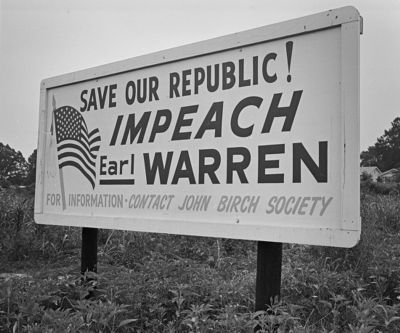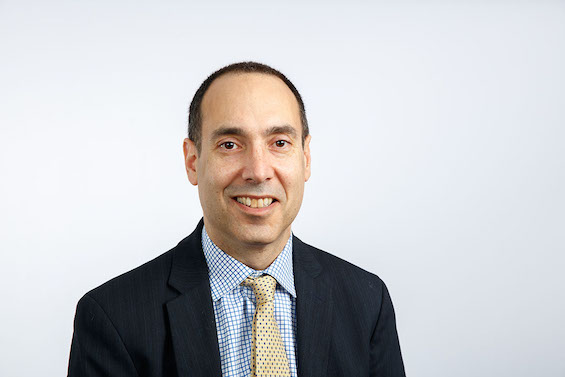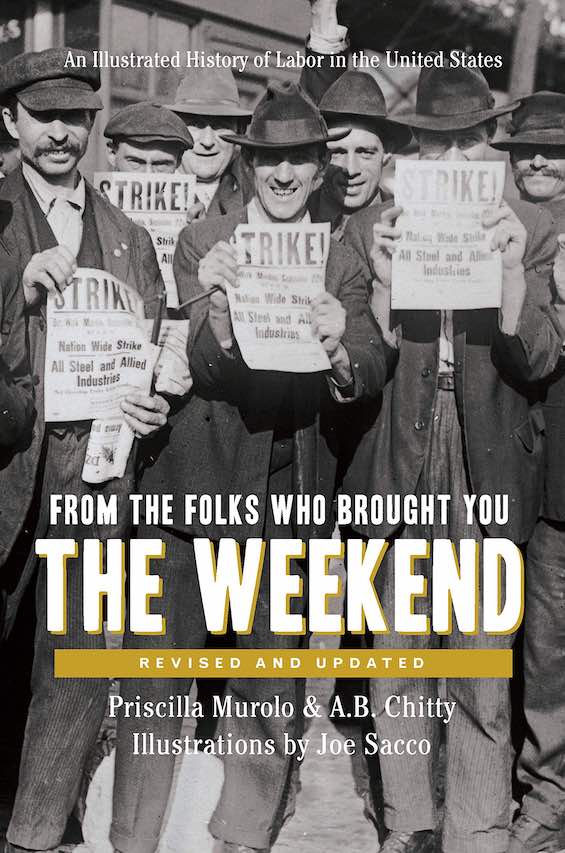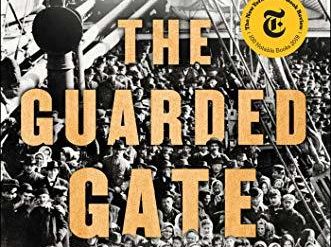
If you wonder who wrote the playbook for the lunatic fringe in today’s Republican Party, look no further than the John Birch Society. Established in 1958, the Society terrorized moderate and liberal Republicans as well as Democrats in the 1960s and early 70s. Its founder, Robert Welch (1899-1985), had called President Dwight Eisenhower “a conscious, dedicated agent of the communist conspiracy.” And the organization’s best known campaign targeted the Chief Justice of the Supreme Court, erecting billboards nationwide calling for support to “Impeach Earl Warren.” In Welch’s addle-brained illogic, even the fluoridation of water represented a communist plot. These were signature issues in Right-Wing extremism in the era of Eisenhower, Kennedy, and Johnson.
But in fundamental ways, the agenda of the Republican Far Right today is nearly identical to that of the John Birch Society in its heyday. And in tracing the history of Right-Wing extremism in the United States, Matthew Dallek demonstrates how its activities beginning six decades ago laid the foundation for the hyper-partisan politics that afflicts American society today.
Estimated reading time: 8 minutes
Sixty years of Right-Wing extremism
Dallek’s thesis is clear at the outset. “You will see,” he writes, “in COVID denialism, vaccine disinformation, America First nationalism, school board wars, QAnon plots, and allegations of electoral cheating, a movement from the 1960s, long thought dead, casting its shadow across the United States.” Each of these threads in the cloth of today’s Right-Wing extremism has its analogue in the agenda and the violence-prone style of the John Birch Society. Although the organization flourished only in the early- to mid-1960s and early 70s, its legacy comes to light on social media, television screens, libraries, and schoolrooms today.
Birchers: How the John Birch Society Radicalized the American Right by Matthew Dallek (2023) 384 pages ★★★★☆

The motives behind the modern Right-Wing movement
Media coverage of today’s Right Wing emphasizes the working-class base on which the movement is grounded. Although many contemporary accounts also point to the ultra-wealthy donors behind it, they still describe the Republican Party today as largely populated by low- and moderate-income people with a high school education or less. But working families have drifted Rightward into the Republican Party only in recent decades. And forgetting that fact obscures the role of the wealthy men—they were all men—who first set the movement’s agenda . . . and the motives that drove them. And so it is today as well. It’s difficult for me to believe that, for most of the ultra-wealthy donors behind the present-day Republican Party, economic motives aren’t still paramount despite their support for the Right-Wing social agenda.
But in 1958 it was even more obvious. Robert Welch and nearly all the eleven men who joined him in setting up the John Birch Society were manufacturers. Six of them, including Welch himself, had served on the board of the National Association of Manufacturers (NAM). And their true agenda, claims to the contrary notwithstanding, was to reverse government regulation of their businesses and lower their taxes. They cloaked their motivation in “anticommunism” and an early version of today’s conservative Christian social agenda.
A shared contempt for unions and civil rights
As Dallek puts it, “NAM ultimately enabled the future Birch founders to combine their shared contempt for unions, communists, liberals, and the mainstream news media into a cohesive anticommunist philosophy with pro-free-market undertones.” Dallek might have added that most of the founders also shared an animus toward African Americans. From the moment when it launched and throughout the years it was active, the John Birch Society outspokenly denounced the Civil Rights Movement as a communist plot. They were unalterably opposed to racial integration.
Dallek sums it up this way: “They sought to use the power of government to enforce white Christian identity in American culture while repudiating allegedly alien values like pluralism and tolerance.”
Just one year after founding the organization, the leadership of the John Birch Society actively considered forming a third party. They “discussed a platform that would abolish the federal income tax, eliminate foreign aid, thwart civil rights, ratify the isolationist Bricker Amendment, and return the United States to the gold standard.” However, they reluctantly chose instead to work within the Republican Party, which to their minds was the lesser of two evils.
A smokescreen of “anticommunism”
Of course, the Cold War was intense in 1958, when the John Birch Society was established, and hysteria about communist plots was widespread in the United States. Although Senator Joseph McCarthy had been discredited and died the preceding year, the House Un-American Activities Committee was still aggressively pursuing “communists” everywhere they looked. In fact, it was exceedingly difficult for any politician, Republican or Democrat, to get elected without a commitment to anticommunism.
Ironically, the membership of the Communist Party of the USA had peaked in 1947 at about 75,000. By 1958, after Stalin’s death and Nikita Khruschchev’s “Secret Speech” revealing his crimes, membership had dropped to fewer than 10,000. And at least 1,500 were law enforcement officers who had infiltrated the party.
The Birch Society founders may even have believed what they said when they spoke about “communists.” But it was clear they knew little or nothing about Marxism-Leninism—or about the activities of the few real communists still active in the country. None of that mattered to them. Their real targets were the liberals in both parties who resisted their call to eliminate regulation of business, shrink government, and lower their taxes.
A primer on Right-Wing extremism
Viewed most broadly, today’s American Right Wing activists tend to share three characteristics. First, a commitment to shrink the federal government, sharply limiting or eliminating regulation of business and drastically reducing taxes. Second, an intense distrust of anyone who is not white, native-born, and Christian. And, third, a willingness to employ whatever tactics might be necessary to get their way, no holds barred. And in all three respects the John Birch Society set the Right on this course beginning in the 1950s.
In Birchers, Dallek traces the evolution of the Right-Wing agenda through the six decades since. Many of the issues—anticommunism, for example—have fallen by the wayside. New ones have risen to the fore, and the culture war has grown more prominent. But in fundamental ways the Right-Wing extremism that led to the mob attack on the United States Congress on January 6, 2021, is no different from that of the John Birch Society in 1958.
The end of civility in American politics
Today we view the 1950s as a peaceful time in our history (the Korean War notwithstanding). A time when civility reigned in politics. But consider what Dallek tells us about the John Birch Society. “Birchers had a well-established, off-putting reputation for being highly aggressive and partial to intimidating tactics. They placed late-night calls, pinned labels like ‘com symp’ on opponents, shouted down speakers, threatened lawsuits, and warned of unspecified consequences for those who crossed them.” Not much different, after all, from the tactics employed by Lee Atwater, Newt Gingrich, and the “MAGA” forces behind Donald Trump. Today’s Right-Wing extremists have grown even more violent—but the pattern was set sixty years ago.
The John Birch Society “offered the far right a language, style, and ideology—confrontational, nationalistic, moralistic—that proliferated in subsequent decades until they finally became the norm within the American right. Its approach featured conspiratorial thinking and an antiestablishment, burn-it-down sensibility.” It would be difficult to find a more economical description of today’s Republican Right Wing.
About the author

Matthew Dallek‘s surname may be familiar since he is the son of historian Robert Dallek, the award-winning author of numerous presidential biographies. The younger Dallek teaches history at the Graduate School of Political Management of George Washington University in Washington, DC. His bio on the university’s website describes him as “a political historian whose intellectual interests include the intersection of social crises and political transformation, the evolution of the modern conservative movement, and liberalism and its critics. Dallek has authored or co-authored four books including, most recently, Birchers.” He is a familiar figure in national news media, speaking on politics, history, and public affairs.
“Dallek earned a B.A. in history from U.C. Berkeley and a Ph.D. in history from Columbia University. Prior to joining GWU, he served as an associate director of the University of California Washington Center. He also worked as a speechwriter for House Minority Leader Richard A. Gephardt. Born and raised in Los Angeles, Dallek lives in Washington with his wife and two sons.”
For related reading
I’ve reviewed four other books about different aspects of the history Matt Dallek reviews in Birchers:
- Right Out of California: The 1930s and the Big Business Roots of Modern Conservatism by Kathryn S. Olmsted (How today’s conservatism grew in the cotton fields of California)
- Dark Money: The Hidden History of the Billionaires Behind the Rise of the Radical Right by Jane Mayer (How the Koch brothers are revolutionizing American politics). The brothers’ father, Fred Koch, was one of the eleven men who cofounded the John Birch Society with Robert Welch.
- The Loudest Voice in the Room: How the Brilliant, Bombastic Roger Ailes Built Fox News—and Divided a Country by Gabriel Sherman (Roger Ailes: the man who built Fox News and divided America)
- Steep: The Precipitous Rise of the Tea Party by Lawrence Rosenthal and Christine Trost (Tea Party politics may not be what you think)
You’ll also find books that examine related issues at:
- The top 5 books about Donald Trump and his impact on American democracy
- Top 10 nonfiction books about politics
- Top 20 popular books for understanding American history
And you can always find my most popular reviews, and the most recent ones, on the Home Page.


























